Comparison of the Efficacy and Welfare of Different Training Methods in Stopping Chasing Behavior in Dogs
Abstract
:Simple Summary
Abstract
1. Introduction
2. Materials and Methods
2.1. Participants and Location
2.2. Study Trainers
2.3. Materials
2.4. Procedure
2.4.1. Day 1
2.4.2. Training
Stopping Word
Group A Procedure: Day 2–Day 4
Group B and Group C Procedure: Day 2, Word Conditioning
Group B Procedure: Day 2, Session 2–Day 4
Group C Procedure, Day 2, Session 2–Day 4
2.4.3. Testing
Test 1
Test 2
Test 3
Test 4
2.5. Cortisol Collection
2.6. Video Analysis and Ethogram
2.7. Data and Statistical Analysis
3. Results
3.1. Participants
3.2. Test Performance
3.3. Cortisol Analysis
3.4. Behavior Analysis
3.5. State Behaviors
4. Discussion
4.1. Limitations
4.2. Ethical Considerations
5. Conclusions
Supplementary Materials
Author Contributions
Funding
Institutional Review Board Statement
Informed Consent Statement
Data Availability Statement
Acknowledgments
Conflicts of Interest
References
- Carter, R.H. Animal Training Device. U.S. Patent No. 2,023,950, 10 December 1935. [Google Scholar]
- Cameron, R.C. Radio Controlled Electric Cutaneous Signal Type Animal Obedience Device. U.S. Patent No. 2,800,104, 23 July 1957. [Google Scholar]
- Pettingill, R.P. Animal Training Collar. U.S. Patent No. 2,996,043, 15 August 1961. [Google Scholar]
- Solomon, R.L.; Wynne, L.C. Traumatic avoidance learning: Acquisition in normal dogs. Psychol. Monogr. Gen. Appl. 1953, 67, 1. [Google Scholar] [CrossRef]
- Christiansen, F.O.; Bakken, M.; Braastad, B.O. Behavioural changes and aversive conditioning in hunting dogs by the second-year confrontation with domestic sheep. Appl. Anim. Behav. Sci. 2001, 72, 131–143. [Google Scholar] [CrossRef] [PubMed]
- Schilder, M.B.; van der Borg, J.A. Training dogs with help [sic] of the shock collar: Short and long term behavioural effects. Appl. Anim. Behav. Sci. 2004, 85, 319–334. [Google Scholar] [CrossRef]
- Schalke, E.; Stichnoth, J.; Ott, S.; Jones-Baade, R. Clinical signs caused by the use of electric training collars on dogs in everyday life situations. Appl. Anim. Behav. Sci. 2007, 105, 369–380. [Google Scholar] [CrossRef]
- Salgirli, Y.; Schalke, E.; Hackbarth, H. Comparison of learning effects and stress between 3 different training methods (electronic training collar, pinch collar and quitting signal) in Belgian Malinois Police Dogs. Rev. Méd. Véterinaire 2012, 163, 530–535. [Google Scholar] [CrossRef]
- Dale, A.R.; Statham, S.; Podlesnik, C.A.; Elliffe, D. The acquisition and maintenance of dogs’ aversion responses to kiwi (Apteryx spp.) training stimuli across time and locations. Appl. Anim. Behav. Sci. 2013, 146, 107–111. [Google Scholar] [CrossRef]
- Dale, A.R.; Podlesnik, C.A.; Elliffe, D. Evaluation of an aversion-based program designed to reduce predation of native birds by dogs: An analysis of training records for 1156 dogs. Appl. Anim. Behav. Sci. 2017, 191, 59–66. [Google Scholar] [CrossRef]
- China, L.; Mills, D.S.; Cooper, J.J. Efficacy of Dog Training with and without Remote Electronic Collars vs. a Focus on Positive Reinforcement. Front. Vet. Sci. 2020, 7, 508. [Google Scholar] [CrossRef]
- Cooper, J.J.; Cracknell, N.; Hardiman, J.; Wright, H.; Mills, D. The welfare consequences and efficacy of training pet dogs with remote electronic training collars in comparison to reward based training. PLoS ONE 2014, 9, e102722. [Google Scholar] [CrossRef]
- Sargisson, R.J.; McLean, I.G. Commentary: Efficacy of Dog Training with and without Remote Electronic Collars vs. a Focus on Positive Reinforcement. Front. Vet. Sci. 2021, 8, 629746. [Google Scholar] [CrossRef]
- de Castro, A.C.V.; Barrett, J.; de Sousa, L.; Olsson, I.A.S. Carrots versus sticks: The relationship between training methods and dog-owner attachment. Appl. Anim. Behav. Sci. 2019, 219, 104831. [Google Scholar] [CrossRef]
- Casey, R.A.; Naj-Oleari, M.; Campbell, S.; Mendl, M.; Blackwell, E.J. Dogs are more pessimistic if their owners use two or more aversive training methods. Sci. Rep. 2021, 11, 19023. [Google Scholar] [CrossRef] [PubMed]
- Vieira de Castro, A.C.; Fuchs, D.; Morello, G.M.; Pastur, S.; de Sousa, L.; Olsson, I.A.S. Does training method matter? Evidence for the negative impact of aversive-based methods on companion dog welfare. PLoS ONE 2020, 15, e0225023. [Google Scholar] [CrossRef] [PubMed]
- Rooney, N.J.; Cowan, S. Training methods and owner-dog interactions: Links with dog behaviour and learning ability. Appl. Anim. Behav. Sci. 2011, 132, 169–177. [Google Scholar] [CrossRef]
- Deldalle, S.; Gaunet, F. Effects of 2 training methods on stress-related behaviors of the dog (Canis familiaris) and on the dog–owner relationship. J. Vet. Behav. 2014, 9, 58–65. [Google Scholar] [CrossRef]
- Hiby, E.F.; Rooney, N.J.; Bradshaw, J.W.S. Dog training methods: Their use, effectiveness and interaction with behaviour and welfare. Anim. Welf. 2004, 13, 63–70. [Google Scholar] [CrossRef]
- Blackwell, E.J.; Bolster, C.; Richards, G.; Loftus, B.A.; Casey, R.A. The use of electronic collars for training domestic dogs: Estimated prevalence, reasons and risk factors for use, and owner perceived success as compared to other training methods. BMC Vet. Res. 2012, 8, 93. [Google Scholar] [CrossRef]
- Masson, S.; Nigron, I.; Gaultier, E. Questionnaire survey on the use of different e-collar types in France in everyday life with a view to providing recommendations for possible future regulations. J. Vet. Behav. 2018, 26, 48–60. [Google Scholar] [CrossRef]
- Johnson, T. A Simple Line between Life and Death: The Leash. VetzInsight. 11 October 2012. Available online: https://www.vin.com/vetzinsight/default.aspx?pid=756&id=5563139 (accessed on 29 July 2024).
- Michaelson Found Animals. How to Tame Prey Chase Drive in a Dog. Available online: https://www.foundanimals.org/control-dogs-predatory-chase-drive/ (accessed on 16 March 2024).
- Pappageorge, B. How to Stop Dog Chasing with an E-Collar. Educator Collars. 5 November 2018. Available online: https://www.educatorcollars.com/blog/stop-dog-chasing-e-collar (accessed on 10 March 2024).
- PetSpy. How to Stop a Dog from Chasing with an E-Collar. PetSpy. 16 April 2023. Available online: https://petspy.com/blogs/dog-training/stop-dog-from-chasing-with-ecollar (accessed on 10 March 2024).
- Baril, K.E. Train Your Dog Not to Chase Wildlife. Animal Wellness Magazine. 14 July 2017. Available online: https://animalwellnessmagazine.com/train-dog-not-chase-wildlife (accessed on 10 March 2024).
- Bangura, W. How to Train Your Dog to Stop Chasing: A Comprehensive Guide. 6 February 2024. The Dog Behaviorist. Available online: https://dogbehaviorist.com/2024/02/06/how-to-train-your-dog-to-stop-chasing-a-comprehensive-guide/ (accessed on 10 March 2024).
- Miller, P. Training Your Dog to Execute an “Extremely Fast” Reliable Recall. 15 August 2012. Available online: https://www.whole-dog-journal.com/training/leash_training/training-your-dog-to-execute-an-extremely-fast-reliable-recall/ (accessed on 10 March 2024).
- Kozlowski, C.P.; Clawitter, H.; Guglielmino, A.; Schamel, J.; Baker, S.; Franklin, A.D.; Powell, D.; Coonan, T.J.; Asa, C.S. Factors affecting glucocorticoid and thyroid hormone production of Island foxes. J. Wildl. Manag. 2020, 84, 505–514. [Google Scholar] [CrossRef]
- Friard, O.; Gamba, M. BORIS: A free, versatile open-source event-logging software for video/audio coding and live observations. Methods Ecol. Evol. 2016, 7, 1325–1330. [Google Scholar] [CrossRef]
- Schatz, S.; Palme, R. Measurement of faecal cortisol metabolites in cats and dogs: A non-invasive method for evaluating adrenocortical function. Vet. Res. Commun. 2001, 25, 271–287. [Google Scholar] [CrossRef] [PubMed]
- Madison, C. How to Teach Your Dog the Emegency Recall. Preventative Vet. 27 May 2021. Available online: https://www.preventivevet.com/dogs/teach-your-dog-the-emergency-recall-come (accessed on 10 March 2024).
- Electronic Collar Manufacturer’s Association (EMCA). FAQ. Available online: http://ecma.eu.com/faq/ (accessed on 23 March 2024).
- Garmin. Garmin Sport Pro: Owner’s Manual. 2015. Available online: https://static.garmin.com/pumac/Sport_PRO_OM_EN.pdf (accessed on 10 March 2024).
- Azrin, N.H.; Holz, W.C. Punishment. In Operant Behavior: Areas of Research and Application; Honig, W.K., Ed.; Appleton-Century-Crofts: Norwalk, CT, USA, 1966; pp. 380–447. [Google Scholar]
- Rankin, C.H.; Abrams, T.; Barry, R.J.; Bhatnagar, S.; Clayton, D.F.; Colombo, J.; Coppola, G.; Geyer, M.A.; Glanzman, D.L.; Marsland, S.; et al. Habituation revisited: An updated and revised description of the behavioral characteristics of habituation. Neurobiol. Learn. Mem. 2009, 92, 135–138. [Google Scholar] [CrossRef] [PubMed]
- Dinsmoor, J.A. Punishment. In Learning and Behavior Therapy; O’Donohue, W.T., Ed.; Allyn & Ba: Boston, MA, USA, 1998; pp. 188–204. [Google Scholar]
- Hineline, P.N.; Rosales-Ruiz, J. Behavior in relation to aversive events: Punishment and negative reinforcement. In APA Handbook of Behavior Analysis, Vol. 1: Methods and Principles; Madden, G.J., Dube, W.V., Hackenberg, T.D., Hanley, G.P., Lattal, K.A., Eds.; American Psychiatric Association: Washington, DC, USA, 2013; pp. 483–512. [Google Scholar] [CrossRef]
- BCSPCA. Emergency Recall—The One World Every Dog Must Know. 25 August 2023. Available online: https://spca.bc.ca/news/emergency-recall/ (accessed on 10 March 2024).
- Marschark, E.D.; Baenninger, R. Modification of instinctive herding dog behavior using reinforcement and punishment. Anthrozoös 2002, 15, 51–68. [Google Scholar] [CrossRef]
- Starling, M.; Spurrett, A.; McGreevy, P. Effects of Lure Type on Chase-related Behavior in Racing Greyhounds. Animals 2020, 10, 2262. [Google Scholar] [CrossRef]
- Accorsi, P.A.; Carloni, E.; Valsecchi, P.; Viggiani, R.; Gamberoni, M.; Tamanini, C.; Seren, E. Cortisol determination in hair and faeces from domestic cats and dogs. Gen. Comp. Endocrinol. 2008, 155, 398–402. [Google Scholar] [CrossRef] [PubMed]
- Bryan, H.M.; Adams, A.G.; Invik, R.M.; Wynne-Edwards, K.E.; Smits, J.E. Hair as a meaningful measure of baseline cortisol levels over time in dogs. J. Am. Assoc. Lab. Anim. Sci. 2013, 52, 189–196. Available online: https://www.ncbi.nlm.nih.gov/pmc/articles/PMC3624789 (accessed on 10 March 2024). [PubMed]
- Schork, I.G.; Manzo, I.A.; De Oliveira, M.R.B.; Costa, F.V.; Palme, R.; Young, R.J.; De Azevedo, C.S. How environmental conditions affect sleep? An investigation in domestic dogs (Canis lupus familiaris). Behav. Process. 2022, 199, 104662. [Google Scholar] [CrossRef]
- Slotta-Bachmayr, L.; Schwarzenberger, F. Faecal cortisol metabolites as indicators of stress during training and search missions in avalanche dogs. Vet. Med. Austria 2007, 64, 110–117. [Google Scholar]
- Uetake, K.; Uchida, H.; Ishihara, J.; Kushima, S.; Tanaka, T. Faecal corticosterone levels of dogs relinquished to a shelter in Japan. Vet. Rec. Open 2015, 2, e000139. [Google Scholar] [CrossRef]
- Zannoni, A.; Pietra, M.; Gaspardo, A.; Accorsi, P.A.; Barone, M.; Turroni, S.; Laghi, L.; Zhu, C.; Brigidi, P.; Forni, M. Non-invasive assessment of fecal stress biomarkers in hunting dogs during exercise and at rest. Front. Vet. Sci. 2020, 7, 126. [Google Scholar] [CrossRef]
- Cobb, M.L.; Iskandarani, K.; Chinchilli, V.M.; Dreschel, N.A. A systematic review and meta-analysis of salivary cortisol measurement in domestic canines. Domest. Anim. Endocrinol. 2016, 57, 31–42. [Google Scholar] [CrossRef] [PubMed]
- Beerda, B.; Schilder, M.B.; van Hooff, J.A.; de Vries, H.W. Manifestations of chronic and acute stress in dogs. Appl. Anim. Behav. Sci. 1997, 52, 307–319. [Google Scholar] [CrossRef]
- Pappageorge, B. 5 Reasons to Use an E-Collar to Train Your Dog. Educator Collars. 15 September 2017. Available online: https://www.educatorcollars.com/blog/remote-training-collar#:~:text=A%20remote%20training%20collar%20gives%20you%20a%20way%20to%20interrupt,that%20they%20can%20learn%20faster (accessed on 10 March 2024).
- Siler, W. How a Shock Collar Changed My Relationship with My Dog. Outside Magazine. 6 October 2022. Available online: https://www.outsideonline.com/outdoor-gear/tools/dog-shock-collar-training-experience/ (accessed on 10 March 2024).
- Domjan, M. Pavlovian conditioning: A functional perspective. Annu. Rev. Psychol. 2005, 56, 179–206. [Google Scholar] [CrossRef] [PubMed]
- Feuerbacher, E.N.; Wynne, C.D. Most domestic dogs (Canis lupus familiaris) prefer food to petting: Population, context, and schedule effects in concurrent choice. J. Exp. Anal. Behav. 2014, 101, 385–405. [Google Scholar] [CrossRef]
- McLennan, T. Does the attention a dog pays to their owner increase after the dog engages in activities that mimic the predatory preferences of that dog (Canis familiaris)? Appl. Anim. Behav. Sci. 2023, 263, 105944. [Google Scholar] [CrossRef]
- Herron, M.E.; Shofer, F.S.; Reisner, I.R. Survey of the use and outcome of confrontational and non-confrontational training methods in client-owned dogs showing undesired behaviors. Appl. Anim. Behav. Sci. 2009, 117, 47–54. [Google Scholar] [CrossRef]
- Makowska, I.J.; Cavalli, C.M. Review of Dog Training Methods: Welfare, Learning Ability, and Current Standards; British Columbia Society for the Prevention of Cruelty of Animals: Vancouver, BC, Canada, 2023. [Google Scholar]
- Arkow, P.S.; Dow, S. Ties that do not bind: A study of the human-animal bonds that fail. In Pet Connection: Its Influence on Our Health and Quality of Life; Anderson, R.K., Allen, B.L., Hart, L.A., Eds.; Center to Study Human-Animal Relationships and Environments: Columbia, MO, USA, 1984. [Google Scholar]
- Wells, D.L.; Hepper, P.G. Prevalence of behaviour problems reported by owners of dogs purchased from an animal rescue shelter. Appl. Anim. Behav. Sci. 2000, 69, 55–65. [Google Scholar] [CrossRef]
- Lindsay, S.R. (Ed.) Handbook of Applied Dog Behavior and Training, Procedures and Protocols; John Wiley & Sons: Hoboken, NJ, USA, 2013; Volume 3. [Google Scholar]
- Fernandez, E.J. The least inhibitive, functionally effective model: A new framework for ethical animal training practices. J. Vet. Behav. 2024, 71, 63–68. [Google Scholar] [CrossRef]
- Johnson, A.C.; Wynne, C.D. Training Dogs with Science or with Nature? An Exploration of Trainers’ Word Use, Gender, and Certification Across Dog-Training Methods. Anthrozoös 2022, 36, 35–51. [Google Scholar] [CrossRef]
- Blackwell, E.J.; Twells, C.; Seawright, A.; Casey, R.A. The relationship between training methods and the occurrence of behavior problems, as reported by owners, in a population of domestic dogs. J. Vet. Behav. 2008, 3, 207–217. [Google Scholar] [CrossRef]
- Johnson, A.C.; Wynne, C.D. Training Methods Used by Dog Guardians in the United States: Prevalence, Sources of Information, and Reasons for Use. Animals 2024, 14, 1310. [Google Scholar] [CrossRef] [PubMed]
- Verified Market Reports. E-Collar for Dog Market Size, Share and Growth. Verified Market Reports. December 2023. Available online: https://www.verifiedmarketreports.com/product/e-collar-for-dog-market/ (accessed on 29 July 2024).
- Hernandez, V. Radio Systems Corporation. EDCV 22-1861 JGB. 28 US #312. 2023. Available online: https://www.classaction.org/media/hernandez-v-radio-systems-corporation.pdf (accessed on 10 March 2024).

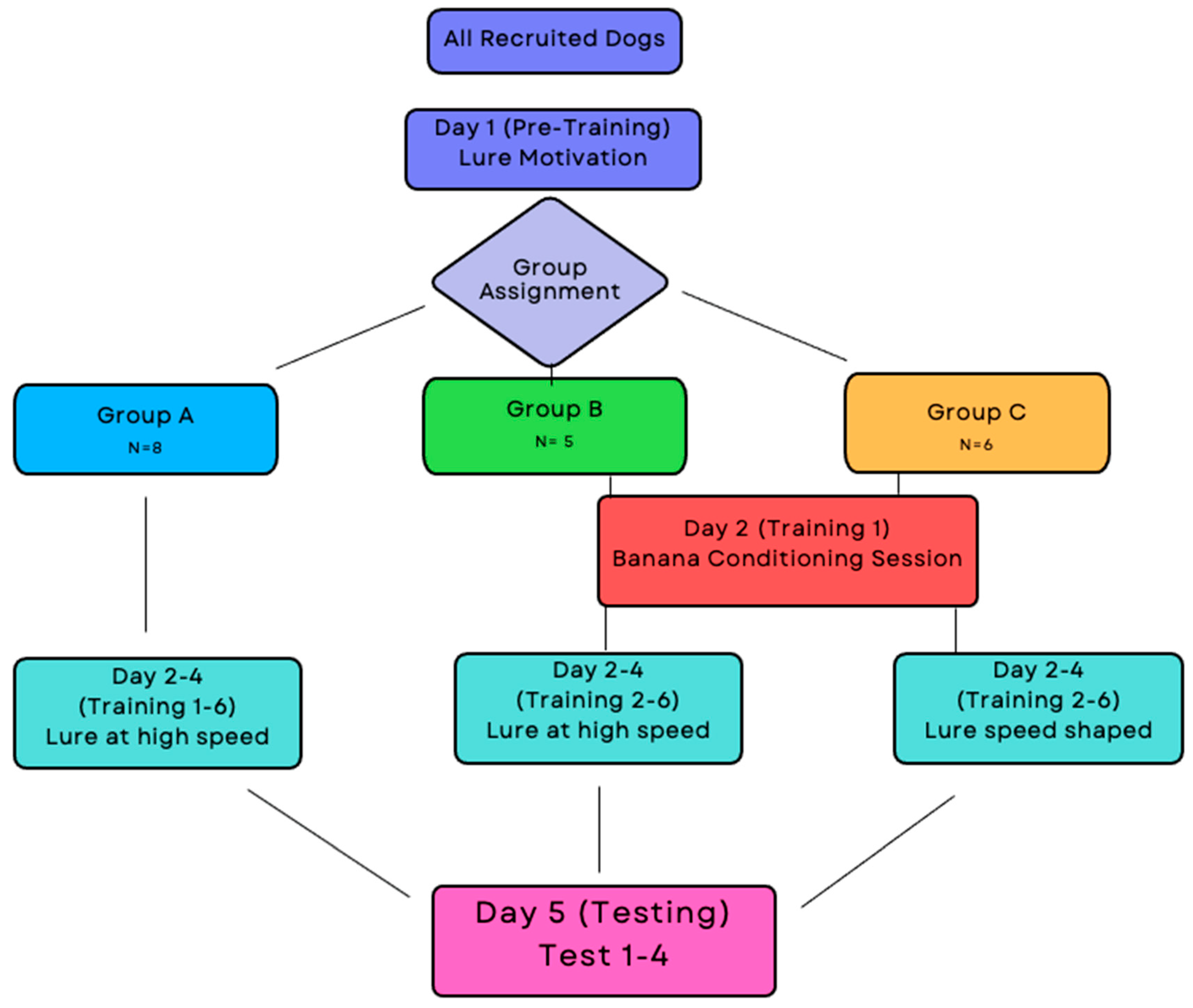

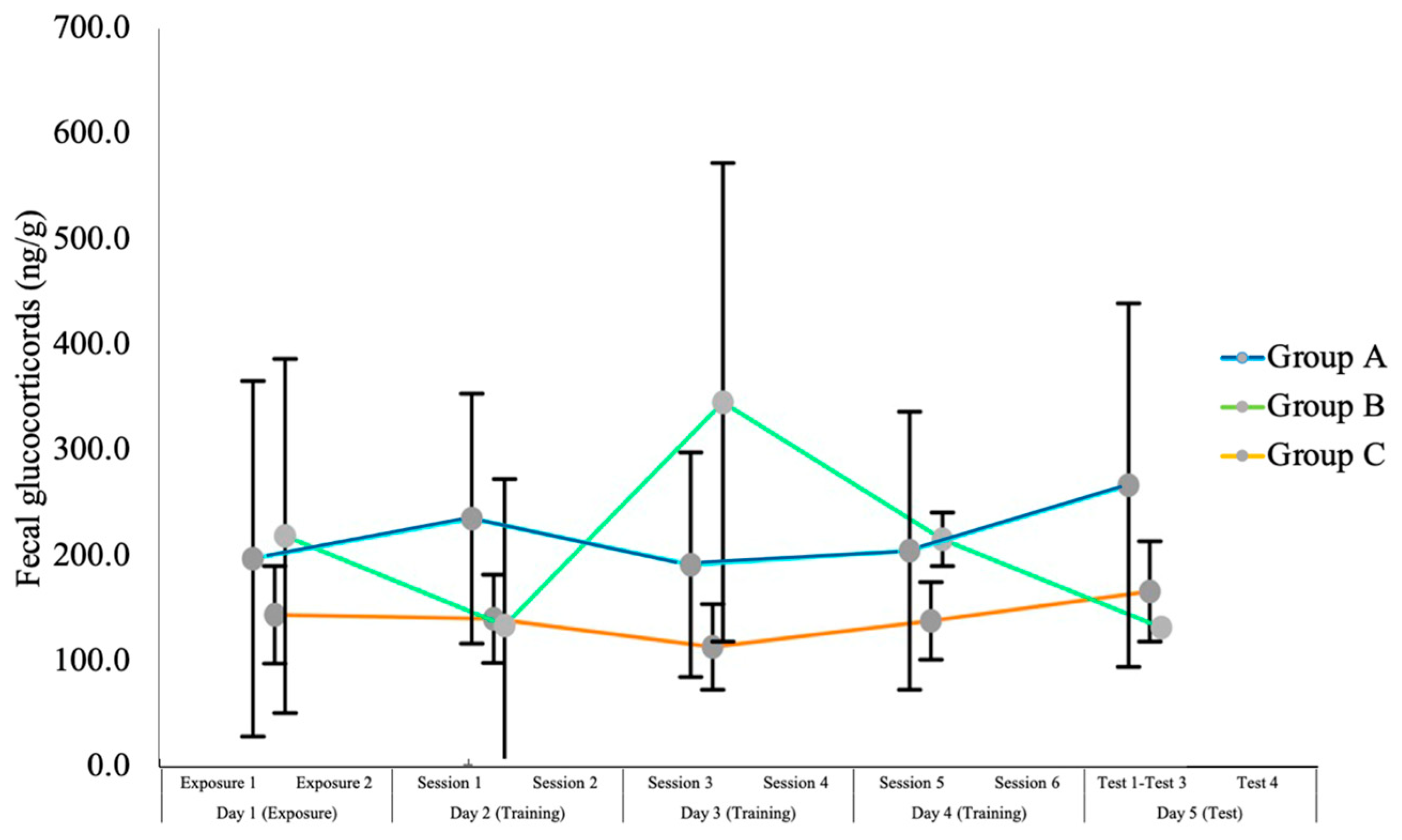
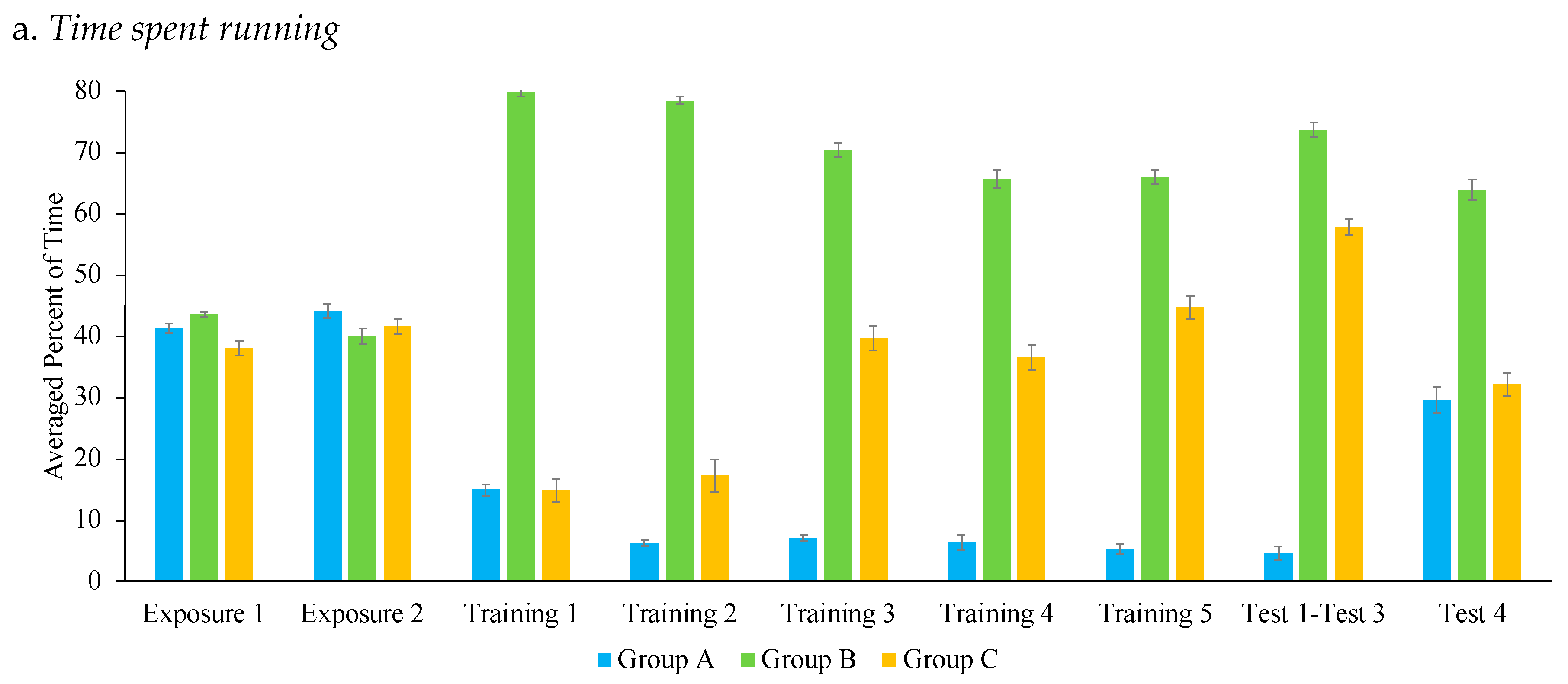
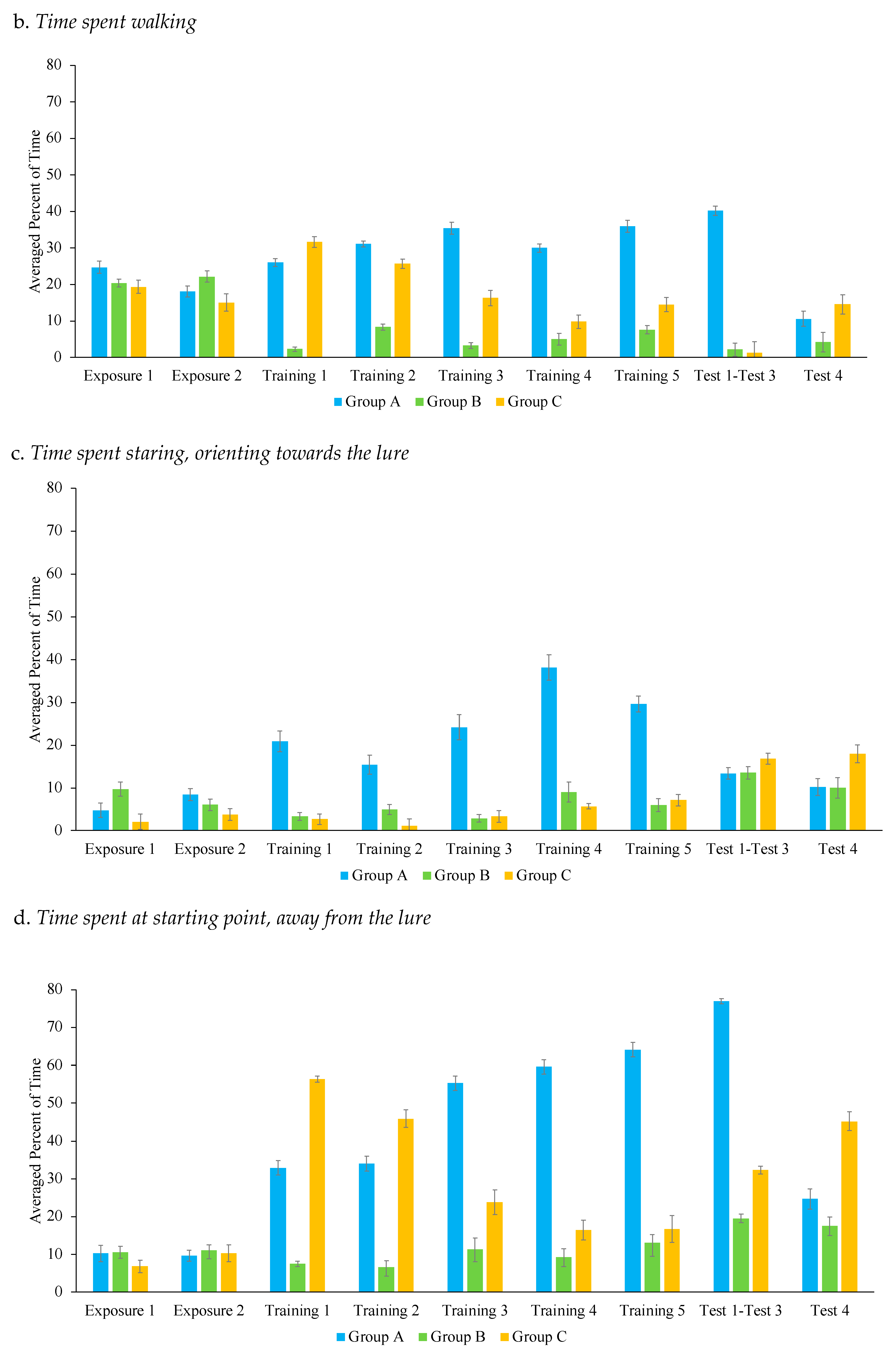

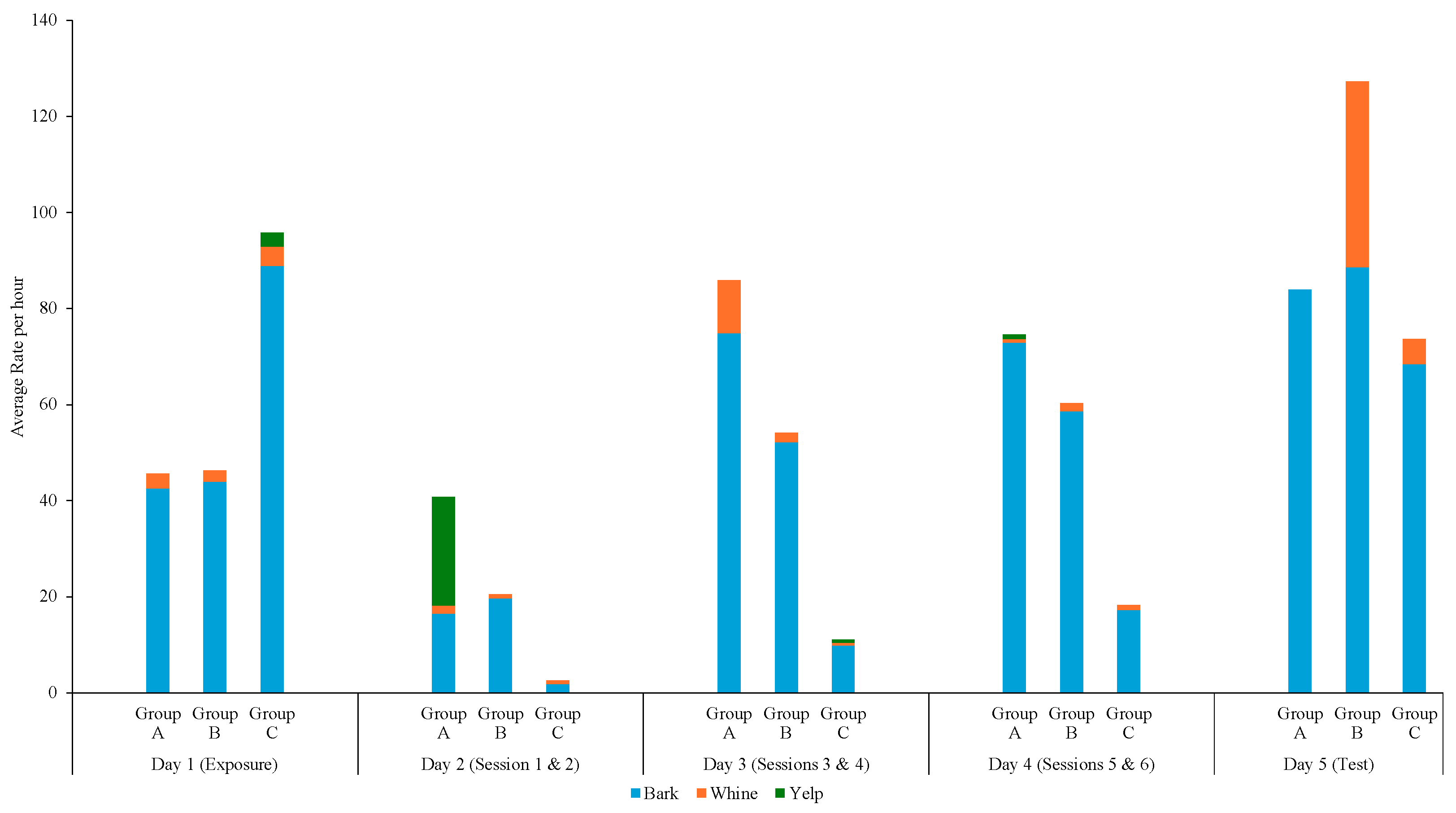
| Section A: | ||
|---|---|---|
| Coded Behavior | Operational Definition | Behavior Type |
| Start position (Away) | Dog is at starting point of training arena; could be standing or laying down in the vicinity of the umbrella. | State |
| Off-Screen | Dog is not present on screen. | State |
| Stare | Dog is still, orientating to direction of the lure course. Could be laying down or standing. | State |
| Bark | Short, low deep vocalization. | Point |
| Yelp | Quick, sharp vocalization; may be once or over a few seconds. | Point |
| Whine | High-pitched vocalization, may be quick or over a prolonged period of time. | Point |
| Growl | Low-pitched, deep rumbling vocalization. | Point |
| Stalk | Dog will be standing upright, still, near lure, or in “play bow” position as if “hunting” lure. | State |
| Running | Dog is moving at a fast pace; at some point, all four paws will be off the ground as it moves. | State |
| Walking | Dog is moving at a slow to moderate pace; movement will vary between 2 and 3 paws on the ground at a time. | State |
| Yawning | Dog opens mouth wide, may occur with or without vocalization. | Point |
| Shake-off | Dog rapidly moves body and/or head, like how a dog may shake off water after a bath. | Point |
| Scratching | Dog stops whatever it is currently doing to use one limb to make repeated contact with its back or neck. | Point |
| Sniffing | Dog directs nose downward or upward to explore an item or substrate for longer than 1 s, end of sniffing bout signified by dog lifting its head which can be accompanied by walking away from the original focal object. | Point |
| Alternative Behavior | Dog is engaged in an activity that is not chasing, running, or standing at the start point. Behaviors can include attempting to elicit play from the humans in the training arena, finding an object to interact with, or rolling on the ground. | State |
| Section B: Section A state behaviors, bark, yelp, whine, growl, yawning, shake-off, scratching, and sniffing were included as part of the coding scheme for Group B and Group C’s Day 2, Training 1 conditioning sessions. Additional coded behaviors are listed and defined below. | ||
| Coded Behavior | Operational Definition | Type of Code |
| Escape | Dog is attempting to exit penned-in area to get to open lure arena; behaviors can include pawing at pen and jumping. | State |
| Eat | Dog is ingesting presented food reward. | Point |
| Sit | Dog has forelimbs extended and is resting on bent hind limbs; can co-occur with “eat”. | Point |
| Lay | Dog is prostrate on the ground, forelimbs may be tucked under body or extended flat on ground in front of body; can co-occur with “eat” | Point |
| Offer | Dog presents a behavior, like sit, paw, or lay down, when treat not present but anticipating treat reward | Point |
| Dog Name | Age (in Months) at Time of Study | Breed | Assigned Group |
|---|---|---|---|
| Calypso | 30 | German Shepherd | Group B |
| Chief | 18 | Belgian Malinois | Group A |
| Gizmo | 18 | Pitbull | Group C |
| Goose | 9 | Doberman | Group A |
| Hazel | 24 | German Shepherd | Group C |
| Jaxson | 36 | Border Collie | Group C |
| Loki | 24 | German Shepherd | Group A |
| Lola | 10 | Doberman | Group B |
| Major | 24 | Pitbull | Group C |
| Marley | 18 | German Shorthaired Pointer | Group B |
| Maya | 30 | Labrador Mix | Group B |
| Mochi | 60 | Alaskan Malamute | Group C |
| Mystery | 24 | German Shepherd | Group C |
| Rocky | 14 | Belgian Malinois | Group A |
| Ruby | 10 | English Labrador | Group A |
| Sage | 20 | Doberman | Group A |
| Tony | 8 | English Labrador | Group B |
Disclaimer/Publisher’s Note: The statements, opinions and data contained in all publications are solely those of the individual author(s) and contributor(s) and not of MDPI and/or the editor(s). MDPI and/or the editor(s) disclaim responsibility for any injury to people or property resulting from any ideas, methods, instructions or products referred to in the content. |
© 2024 by the authors. Licensee MDPI, Basel, Switzerland. This article is an open access article distributed under the terms and conditions of the Creative Commons Attribution (CC BY) license (https://creativecommons.org/licenses/by/4.0/).
Share and Cite
Johnson, A.C.; Wynne, C.D.L. Comparison of the Efficacy and Welfare of Different Training Methods in Stopping Chasing Behavior in Dogs. Animals 2024, 14, 2632. https://doi.org/10.3390/ani14182632
Johnson AC, Wynne CDL. Comparison of the Efficacy and Welfare of Different Training Methods in Stopping Chasing Behavior in Dogs. Animals. 2024; 14(18):2632. https://doi.org/10.3390/ani14182632
Chicago/Turabian StyleJohnson, Anamarie C., and Clive D. L. Wynne. 2024. "Comparison of the Efficacy and Welfare of Different Training Methods in Stopping Chasing Behavior in Dogs" Animals 14, no. 18: 2632. https://doi.org/10.3390/ani14182632





